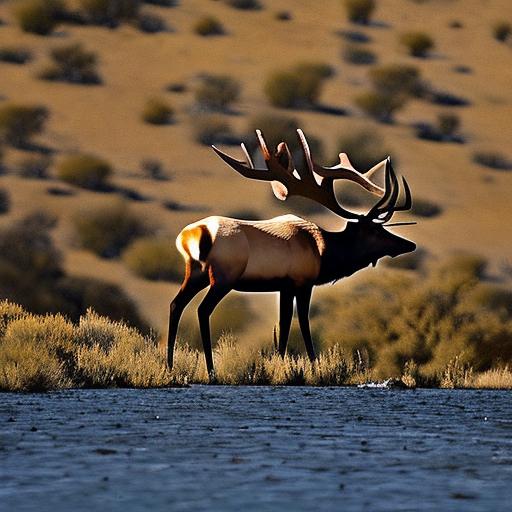Your cart is currently empty!

The Thrill of the Hunt: Tule Elk Hunting in California’s Wilderness

Tule elk hunting is a popular activity in California, attracting hunters from all over the country. It offers a unique and thrilling experience, as hunters have the opportunity to pursue one of North America’s largest land mammals. Tule elk are known for their impressive size and majestic antlers, making them a prized trophy for hunters.
I remember my first tule elk hunting trip like it was yesterday. The crisp morning air, the anticipation of the hunt, and the adrenaline rush when I finally spotted a magnificent bull elk in my sights. It was an experience that I will never forget, and it ignited a passion for tule elk hunting that has stayed with me ever since.
Key Takeaways
- Tule elk hunting is a thrilling and rewarding experience that requires preparation and knowledge.
- Tule elk were once on the brink of extinction in California, but conservation efforts have helped their population rebound.
- Proper gear and safety precautions are essential for a successful and safe hunt.
- Choosing the right hunting grounds and timing your hunt during the rut can increase your chances of success.
- Tracking and stalking techniques are important skills to master for a successful hunt.
The History of Tule Elk in California
Tule elk have a rich history in California, dating back thousands of years. They are native to the state and were once abundant throughout the region. However, due to overhunting and habitat loss, their population declined dramatically in the late 19th century. At one point, it was believed that tule elk were extinct.
Fortunately, a small herd of tule elk was discovered in the late 1800s in the Tule Elk Reserve near Bakersfield, California. This discovery led to efforts to protect and restore the population of tule elk in California. Today, tule elk can be found in various parts of the state, including Point Reyes National Seashore and Owens Valley.
Preparing for the Hunt: Gear and Safety Tips
Before embarking on a tule elk hunting trip, it is important to ensure that you have the right gear and are prepared for any potential safety risks. Some essential gear for tule elk hunting includes a high-powered rifle with appropriate ammunition, binoculars or a spotting scope for scouting and tracking, camouflage clothing to blend into the surroundings, and sturdy boots for traversing rugged terrain.
Safety should always be a top priority when hunting. It is crucial to familiarize yourself with firearm safety rules and regulations, and to practice proper gun handling techniques. Additionally, it is important to have basic wilderness survival skills, such as navigation, first aid, and knowledge of local wildlife and plants.
Choosing the Right Hunting Grounds
| Factors | Importance | Metrics |
|---|---|---|
| Location | High | Distance from home, accessibility, terrain, weather |
| Game Population | High | Number of animals, species diversity, hunting pressure |
| Regulations | Medium | Licensing requirements, bag limits, season dates, weapon restrictions |
| Cost | Medium | Travel expenses, lodging, equipment, guide fees |
| Experience | Low | Personal preferences, previous success, familiarity with the area |
When selecting a hunting location for tule elk, there are several factors to consider. One of the most important factors is the terrain. Tule elk are known to inhabit areas with dense vegetation and marshy habitats, so it is important to choose a hunting ground that offers suitable cover for the animals.
Accessibility is another important consideration. Some hunting grounds may require a long hike or difficult terrain to reach, while others may be more easily accessible by vehicle. It is important to assess your physical abilities and choose a hunting ground that matches your skill level.
Scouting potential hunting grounds is also crucial for success. This involves researching the area, talking to local hunters or guides, and visiting the location prior to the hunt to familiarize yourself with the terrain and potential elk sightings.
The Best Time of Year to Hunt Tule Elk
The best time of year to plan a tule elk hunting trip depends on various factors, including breeding and migration patterns. Tule elk typically breed in late summer or early fall, which means that the rutting season occurs during this time. The rutting season is when male elk compete for mates and can be an ideal time for hunting, as bulls are more active and vocal.
Migration patterns can also influence the best time of year to hunt tule elk. During certain times of the year, tule elk may migrate from higher elevations to lower elevations in search of food and water. By understanding these migration patterns, hunters can strategically plan their trips to increase their chances of success.
Tracking and Stalking Techniques

Tracking and stalking tule elk requires patience, skill, and a keen eye. One of the most effective tracking techniques is to look for signs of elk activity, such as tracks, droppings, and rubs on trees. By studying these signs, hunters can determine the direction and proximity of the elk.
Binoculars or a spotting scope are essential tools for tracking tule elk. These optics allow hunters to scan the landscape for elk and assess their size, antler configuration, and behavior from a distance. This can help hunters determine if a particular elk is worth pursuing.
Stalking tule elk requires stealth and the ability to move quietly through the landscape. It is important to stay downwind of the elk to avoid being detected by their keen sense of smell. Moving slowly and deliberately, using available cover such as trees or bushes, can help hunters get closer to their target without being noticed.
The Thrill of the Hunt: Adrenaline and Excitement
Tule elk hunting is not for the faint of heart. The thrill of the hunt is unlike any other experience, as hunters must rely on their skills, instincts, and knowledge of the animal to outsmart their prey. The adrenaline rush that comes with spotting a majestic bull elk in your sights is indescribable.
The mental and physical challenges of tule elk hunting add to the excitement. Hunting requires patience, perseverance, and the ability to adapt to changing conditions. It tests your physical endurance as you navigate rugged terrain and endure long hours in the field. But the rewards are well worth it.
Ethical Hunting Practices and Conservation Efforts
Ethical hunting practices are essential for preserving wildlife populations and ensuring the sustainability of hunting opportunities for future generations. This includes practicing fair chase, which means giving animals a fair chance to escape and not using unfair advantages or methods to hunt them.
Respect for the animal is also a key aspect of ethical hunting. This means making clean and humane kills, using the meat and other parts of the animal responsibly, and minimizing waste. It is important to treat the animal with dignity and gratitude for providing sustenance and a memorable hunting experience.
Conservation efforts play a crucial role in protecting tule elk populations. Organizations such as the California Department of Fish and Wildlife work to manage and monitor elk populations, enforce hunting regulations, and preserve habitat for tule elk. By supporting these conservation efforts, hunters can contribute to the long-term survival of tule elk.
Processing and Cooking Tule Elk Meat
Processing and cooking tule elk meat is an important part of the hunting experience. Proper processing ensures that the meat is safe to consume and maximizes its flavor and tenderness. It is important to field dress the animal as soon as possible after the kill to prevent spoilage.
Once the animal is field dressed, it can be transported to a processing facility or butcher for further processing. This may include skinning, quartering, and packaging the meat for storage or immediate consumption. It is important to follow proper food safety guidelines during this process to prevent contamination.
Tule elk meat is lean and flavorful, making it a versatile ingredient in various recipes. It can be prepared in a variety of ways, including grilling, roasting, or braising. Some popular recipe ideas for tule elk meat include elk steaks with a red wine reduction, elk chili, or elk burgers.
The Rewards of Tule Elk Hunting: Memories and Experiences That Last a Lifetime
The rewards of tule elk hunting go beyond the thrill of the hunt and the satisfaction of a successful harvest. The memories and experiences that are created during a hunting trip can last a lifetime. Whether it’s bonding with friends or family in the great outdoors, witnessing the beauty of nature up close, or challenging yourself both mentally and physically, tule elk hunting offers a unique and unforgettable experience.
I encourage anyone who has an interest in hunting and a love for the outdoors to give tule elk hunting a try. It is an opportunity to connect with nature, challenge yourself, and create memories that will last a lifetime. So grab your gear, prepare for the hunt, and embark on an adventure that you will never forget.
Tule elk hunting is a popular and thrilling activity in California. It offers hunters the opportunity to pursue one of North America’s largest land mammals and create memories that will last a lifetime. By understanding the history of tule elk in California, preparing for the hunt with the right gear and safety precautions, choosing the right hunting grounds, and mastering tracking and stalking techniques, hunters can increase their chances of success. Ethical hunting practices and conservation efforts are also crucial for preserving tule elk populations and ensuring the sustainability of hunting opportunities. Finally, processing and cooking tule elk meat allows hunters to enjoy the fruits of their labor and savor the flavors of this lean and flavorful meat. So why not give tule elk hunting a try? Share your own experiences or ask questions in the comments section below.
If you’re interested in tule elk hunting, you might also want to check out this article on “How to Hunt Grouse Without a Dog” from Old Oak Syndicate. Grouse hunting can be a thrilling and challenging experience, and this article provides valuable tips and techniques for hunters who prefer to hunt without the assistance of a dog. Whether you’re a seasoned hunter or just starting out, this article is a great resource for improving your grouse hunting skills. Read more
FAQs
What is tule elk hunting?
Tule elk hunting is the act of pursuing and killing tule elk for sport or food.
Where can tule elk hunting take place?
Tule elk hunting can take place in areas where tule elk populations exist, such as California.
Is tule elk hunting legal?
Tule elk hunting is legal in certain areas and under certain regulations. It is important to check with local authorities and obtain the necessary permits and licenses before hunting.
What are the regulations for tule elk hunting?
Regulations for tule elk hunting vary by location and can include restrictions on hunting seasons, bag limits, and weapon types. It is important to research and follow all regulations to ensure a legal and ethical hunt.
What is the history of tule elk hunting?
Tule elk were once hunted to near extinction in the late 1800s, but conservation efforts have helped to increase their populations. Today, tule elk hunting is regulated to ensure sustainable populations and to support conservation efforts.
What are the ethical considerations of tule elk hunting?
Ethical considerations of tule elk hunting include ensuring a quick and humane kill, respecting the animal and its habitat, and following all regulations and laws. It is important to hunt responsibly and with respect for the animal and the environment.

Herb has been a longtime lover of the outdoors. Whether it be hunting, camping, fishing or just getting outside to reset. Proud father and animal lover. Bourbon anyone?

by
Tags:
Comments

Categories
- Big Game Hunting (301)
- Deer (202)
- Reviews (3)
- Shooting (16)
- Slingshot (1)
- Small Game Hunting (42)
- Upland Hunting (126)
- Waterfowl Hunting (3)





Leave a Reply